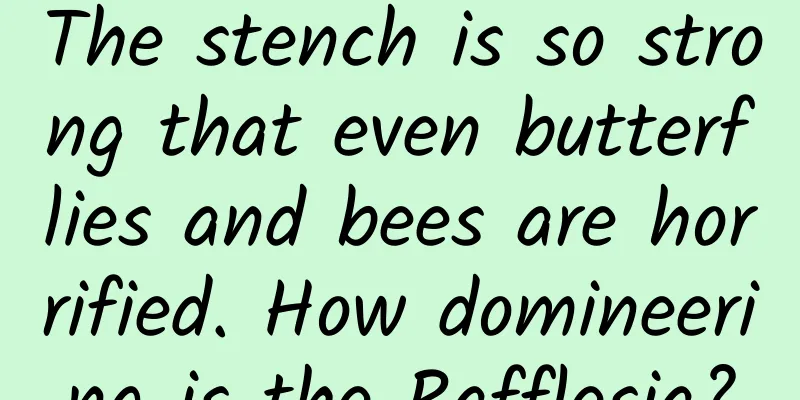The stench is so strong that even butterflies and bees are horrified. How domineering is the Rafflesia?

|
In the Pokemon game, there is a Pokemon that emits a stinky smell while walking. It is the Queen of Flowers, which evolved from the Smelly Flower. The Queen of Flowers has a spherical blue torso and limbs, and a "red flower" on its head that is much larger than its body, which looks very inconsistent. The big red flower on the top of the King Flower looks very much like the King Flower in our nature. It has five huge bright red petals with white spots, and in the middle of the petals is an orange-red jar-like main axis. According to the Pokémon encyclopedia, Queen of the Night has the largest and most spectacular petals in the world. In fact, the prototype of Queen of the Night is indeed based on the Rafflesia in the real world during its blooming period. The prototype of the queen flower - Rafflesia Rafflesia is the general name for the genus Rafflesia in the Rafflesia family. Rafflesia's relatives in the Rafflesia family include castor, cassava, rubber trees, etc. Rafflesia is called the "king of flowers". It has a spectacular and strange appearance and blooms the largest single flower known to science. The world's largest Rafflesia - Rafflesia arnoldii from the tropical rainforest of Sumatra even weighs 7.5 kilograms and has a diameter of more than 1 meter. Image source: GBIF Rafflesia is named after Sir Stamford Raffles, who has been devoted to the study of Rafflesia. He and his partner, British botanist Dr. James Arnold, have a good story: in 1818, they discovered the largest Rafflesia and named it "Rafflesia arnoldii". Unfortunately, Dr. Arnold died of malaria before he could complete his research on Rafflesia. Later scholars named this flower "Arnold Rafflesia" in memory of this pioneer in the field of Rafflesia. However, humans may have discovered the Rafflesia flower as early as 1797. That year, French explorer Louis Auguste Deschamps collected the first specimen of the Rafflesia flower on the island of Java in Indonesia and made detailed observations and records. Unfortunately, a year later, the Anglo-French War broke out. When he returned to Europe, his ship was detained in Britain, so all his articles and notes on plants were confiscated and sealed, including the first record of the Rafflesia flower in human history, which did not reappear until 1953. The “Stealing” Life of Rafflesia Rafflesia is found in Malaysia, Indonesia, Sumatra and other places. Although Rafflesia is a true plant (fleshy parasitic herb), it challenges the traditional definition of plants. They are parasitic plants and need to rely on the host to provide nutrients to survive. Rafflesia prefers to parasitize on the genus Tetrastigma in tropical rainforests hundreds of meters above sea level. Most of the time, this parasite lives quietly inside the stems and roots of the host. It takes several months for the flower buds to grow into large red, fleshy, cabbage-shaped flowers, which only last for a few days. Rafflesia is more similar to fungi, has no chlorophyll and therefore cannot photosynthesize. To obtain food, they form filaments towards the vines and absorb water and nutrients from them. Distribution map of Rafflesia. Image source: GBIF The blooming Rafflesia has an innate "king" demeanor. They are colorful, with bright red corollas and dense white spots. There is a large round-mouthed honey jar in the center of the flower, some of which are so large that they can accommodate human cubs. Although it has no roots, stems or leaves, the Rafflesia flower has basically retained the way of reproduction as a plant - pollination is completed through insect pollination. At the beginning of blooming, the smell of Rafflesia is fragrant, but the flowering period is short, and soon they emit the stench of rotten meat. Because of its extremely strange smell, butterflies, bees or other small animals will stay away from it, and only flies and other insects that chase odors will spread pollen for them. Although botanists have not yet fully elucidated how the seeds of Rafflesia enter the host, Rafflesia has another wonderful connection with its host - they can grab the host's genome while parasitizing and pass it on from generation to generation. Professor Charles Davis, a botanist at the University of Michigan, and his team are working to study the genetic secrets of Rafflesia. Professor Charles Davis published an article in Science pointing out that the parasitic relationship may promote horizontal gene transfer (HGT) between the host and Rafflesia. HGR refers to the exchange of genes between species with reproductive isolation or between organelles. However, horizontal gene transfer generally occurs in prokaryotes such as bacteria and a small number of single-cell eukaryotes, and eukaryotes rarely undergo horizontal gene transfer. Professor Davis' team used multi-gene phylogenetic analysis to study Rafflesia. The results showed that the mitochondrial and nuclear sites of Rafflesia are similar to those of Malvaceae, and are likely located near the Tropaeolaceae or Mangosteenaceae. However, mitochondrial nad1B-C place them in relatives of the Vitaceae family and close to their obligate host, Creepingia. These inconsistent phylogenetic hypotheses strongly suggest that part of the mitochondrial genome of Rafflesia was acquired from the host by HGT. Unfortunately, the current situation of the Rafflesia is not optimistic. Due to the massive deforestation of tropical rainforests caused by human activities and the long life cycle but short flowering period of the Rafflesia, the Rafflesia is now endangered. Since humans have discovered this wonderful species, they should also protect its existence. Only when humans and nature make peace can we enjoy the wonders and beauty of the world. References: [1] Pokémonpedia: Pokémon Queen https://wiki.52poke.com/wiki/%E9%9C%B8%E7%8E%8B%E8%8A%B1#.E6.9D.A5.E6.BA.90 [2] A Bi. Strange Plants - Rafflesia [J]. Greening and Life, 2007(01):40. [3] Plant Intelligence http://www.iplant.cn/info/%E5%A4%A7%E8%8A%B1%E8%8D%89%E7%A7%91?t=z [4]https://www.163.com/dy/article/DMM9E1EJ0520CTBV.html [5] http://homepages.wmich.edu/~tbarkman/rafflesia/Rafflesia.html [6] Lu Zhaosheng. Only one flower blooms in a lifetime[J]. Yilin (Youth Edition), 2020(03):25. [7]DAVIS CC, WURDACK K J. Host-to-parasite gene transfer in flowering plants: Phylogenetic evidence from malpighiales [J]. Science, 2004, 305(5684): 676-8. Review expert: Ran Hao, a well-known popular science writer. |
>>: The cute incarnations of ice and snow: How Bing Dwen Dwen and Shuey Rhon Rhon were born
Recommend
5 tips for Facebook advertisers to increase ROI!
There is no doubt that Facebook has a lot to offe...
[Smart Farmers] The power of seeds: Uncovering the "treasure genes" of the National Tea Germplasm Resource Garden
A tiny seed contains huge potential. An excellent...
The skinny old man is a big hit! Young people today give up takeout and fall in love with "white people's food"...
Recently, the whole network has been learning to ...
Tencent admits to being a coward for the first time. People who have been tortured by WeChat for many years finally get their revenge.
[[318009]] On March 9, Tencent’s WeChat made head...
Waymo enters China, can Baidu beat Google again this time?
Recently, the industrial and commercial informati...
How to trigger user growth? (The most complete mind map)
In fact, user growth is very common in our lives....
There is a big "sausage" stuck by the water. If you dare to eat it, your mouth will be covered with frying!
In this week's "Museum Calendar", a...
Zhihu operates the neglected traffic pool
I am one of the earliest users of Zhihu. During t...
How does the gaming business, which accounts for 83.4% of Bilibili’s revenue, operate?
Recently, bilibili released its IPO prospectus, a...
Omdia: Global Medical AI Software Market Size Reached $823 Million in 2019
Omdia considers the healthcare artificial intelli...
Smart masks are here! Make breathing more "smart"
Author Li Chuanfu Recently, scientists published ...
Is your child's myopia increasing rapidly? Maybe you didn't choose the right glasses! Parents must read these 3 points!
Before the age of thirteen, it is an important st...
In-depth: Momo, Weibo and Kuaishou, the three video giants will eventually face off
Weibo has a market value of 17.2 billion yuan, Mo...
Xianyang Mini Program Development Company, how much does it cost to develop a voting mini program?
There is no doubt that the topic of mini programs...
4 steps to execute and implement event operations
How to execute and implement a complex and large-...









